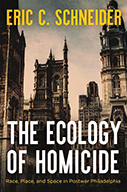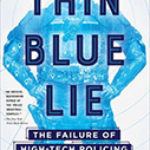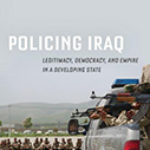The Ecology Of Homicide: Race, Place, And Space In Postwar Philadelphia

Author: Eric C. Schneider
Publisher: Philadelphia: University of Pennsylvania Press, 2020. 264p.
Reviewer: James Wolfinger | September 2021
Eric Schneider, who unfortunately passed away in the midst of writing The Ecology of Homicide, begins his work with a central question: “Why do African American men kill one another, as well as others, with such alarming frequency?” (1). In searching for the answer, Schneider dug deeply into the Philadelphia City Archives, examining the records generated by every tenth murder case from the 1940s to the 1980s. Schneider certainly understands how politically charged his study could be, with critics potentially arguing it reinforces stereotypes about Black male violence. Yet in the author’s view, “social problems are not solved through silence,” and his investigation is critical for helping us understand why “murder is a black man’s disease” (xix).
Schneider offers a brief tour through current theories about African American violence: a subculture of violence from the South; a subculture of inner-city violence; a value system often termed the “code of the street”; gendered violence; long-term civilizing or decivilizing processes; industrialization and deindustrialization; and trust in social institutions. He finds all of these explanations wanting (2-5). Instead, he argues that segregation in Philadelphia’s neighborhoods and workplaces led to an “ecological structuring of behavior” that produced high levels of violence (7). Mix in alcohol and, in later years, heavier narcotics along with infidelity, and murder occurs with alarming, numbing, frequency.
At its best, Schneider’s work highlights the spacing and interdependence of people and institutions that constitutes what he calls the “ecology of homicide” (xxi). This sociological analysis, drawing on a large number of cases to develop a theory underpinning the observed social activity of homicide, appears most impressively in the book’s early chapters on postwar Philadelphia and murders involving women. These chapters adeptly tell a series of stories of homicide, often making for difficult reading, that he assembles into an argument about how social structures around jobs, housing, and policing created a pressure cooker that often ended in violence.
Other chapters, however, focus heavily on a single case, such as the 1958 murder of Penn graduate student In-Ho Oh, or largely shift away from homicide to detail the 1964 uprising in North Philadelphia, or the development of Police Advisory Boards. These are worthy topics, but they highlight the unevenness of the book. When Schneider draws on gripping case studies to build a larger sociological theory about murder, his book offers compelling insights. At other times the book is less focused, dwelling for many pages on single events with only limited explication of what the case means, or losing the thread about homicide to explore policing more broadly.
The book is brief, at only 111 pages of text, and more suggestive than authoritative. It lacks a conclusion that would help readers piece together what it all means, how we should understand the case studies on a broader level. Schneider’s colleague, Howard Gillette, Jr., performed an admirable service in facilitating Ecology’s publication, but he did not attempt to complete the book (ix). It is thus lamentable but understandable that one catches glimpses of Schneider’s effort to produce “an intimate record, a set of narratives, with which to understand the lives of poor people, the history of a great city, and the soul of violence itself” but that Schneider’s unfortunate passing left the book incomplete (xxi).
James Wolfinger, Dean of the College of Education and Professor of History, Illinois State University


